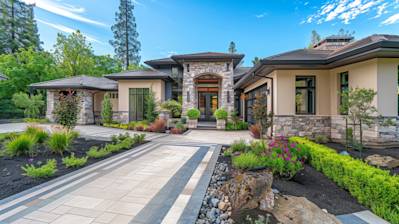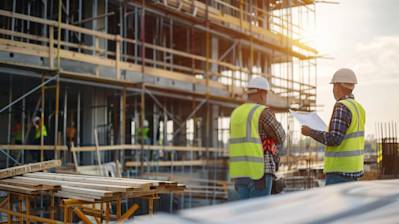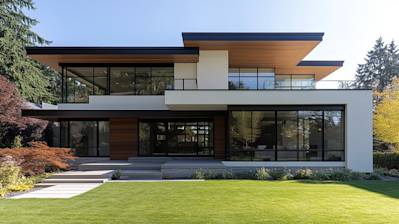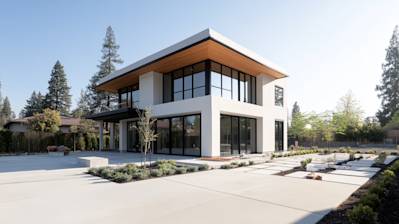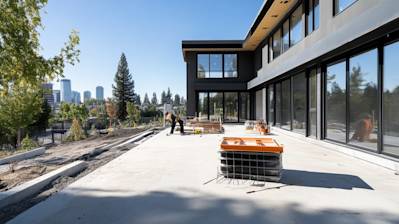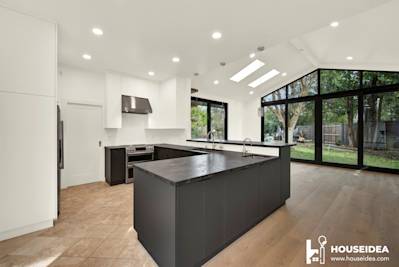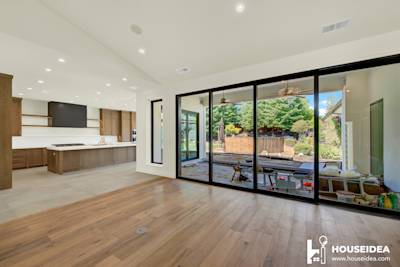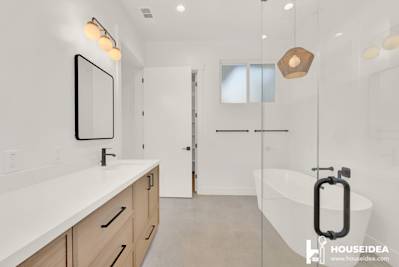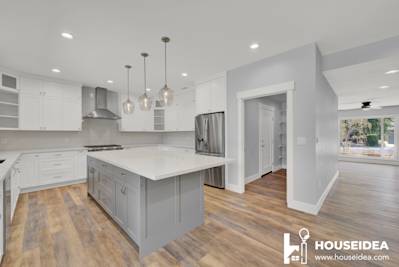Every building that you see around is typically a result of an architect’s creative vision. Understandably, answers to the question "What do architects do?" extend far beyond simply drawing blueprints for buildings. This blog will delve into the multifaceted role of architects, exploring their responsibilities, the tools they use, and the steps taken to design a structure, bringing visions to life.
The Architect: A Descriptor beyond a Designer
The role of an architect often intertwines with that of a designer, planner, environmental consultant, and more. Here’s an overview of the array of responsibilities they undertake:
- Primary Designers: Architects transform client's needs and wants into design concepts and develop these concepts into functional and aesthetically pleasing architectural plans.
- Engineering Liaisons: They work closely with various engineers to incorporate electrical, mechanical, and structural strategies into the building plans.
- Budget Managers: Architects are responsible for estimating costs and establishing a budget, considering the client’s fiscal capabilities.
- Quality Supervisors: They oversee the construction process, ensuring the builders adhere to the design, quality of construction, and use of materials.
- Environment Consultants: They perform an important role in promoting environmentally friendly design principles from material selection to site orientation.
The Architect’s Palette: Tools of the Trade
To fulfill the responsibilities above, an architect utilizes several tools. The tools of an architect can range from the traditional – such as drawing boards and pencils – to state-of-the-art – such as architectural software.
- Drafting Boards and Pencils: Although many architects now use computers, freehand drawing skills are still seen as an integral part of the design process.
- Complex Software: They use modeling tools like AutoCAD, SketchUp, and Revolutionary BIM to create detailed blueprints.
- Physical Models: Architects often construct extensive physical models out of cardboard and other materials to help visualize the final product.
Designing the Vision: Architects Process
The process architects follow while designing a structure can be split into several distinct stages:
Concept Development
The initial design meeting between client and architect allows an exchange of ideas, establishing a conceptual framework. The architect performs analysis considering regional laws, climate, and available materials. Sketches are brought to life using both traditional and digital tools to create a preliminary design.
Schematic Design
In the schematic design phase, architects translate the initial concept into the architectural language illustrated with diagrams, plans, and 3D models. They incorporate details like room sizes, traffic flow, and overall layout.
Design Development
Architects fine-tune the design in this phase, deciding on materials, colors, and overall aesthetics. Close collaboration with the structural engineer enables the selection of support systems, configurations, material sizes, and more.
Construction Documentation
In this crucial phase, extensive drawings and specifications are created. These documents guide the contractors during the construction, detailing the structure's appearance and systems.
Construction Administration
Architects monitor the construction to ensure that the building is constructed according to the plans. They visit the site, review reports, and respond to any unforeseen issues.
Post-Construction
Once the construction is fully completed, architects walk through the building, creating a punch list of minor tweaks, adjustments, or repairs to be made.
Frequently Asked Questions about What Do Architects Do?
How Do Architects Create Building Designs?
Creating a building design is a multifaceted process which an architect navigates. This commences with the conceptualization of ideas influenced by the architect's creative vision, the client's specifications, and limitations imposed by laws and the physical environment. Next, this vision is transformed into blueprints using specialized software. These blueprints serve as a comprehensive guide for the builders.
What Role Do Architects Play in Construction?
Architects are more involved in the construction process than many people realize. They are present at the construction site, monitoring the builders, and ensuring that the construction stays true to their design. They oversee the progress of work, solve issues that can crop up during the construction, and confirm that everyone adheres strictly to the design, quality, and safety standards outlined.
How Do Architects Incorporate Sustainability into Their Design?
Architects are increasingly becoming key players in promoting environmental sustainability. They achieve this by incorporating energy-efficient components, using sustainable construction materials, and designing buildings that make the most of natural energy sources. This practice of sustainable architecture aims to minimize the negative environmental impact of buildings.
Do Architects Work Alone or as Part of a Team?
Architects frequently work as part of a diverse team. These teams can include other architects, civil engineers, landscape architects, urban planners, interior designers, and other professionals involved in the construction process. This interdisciplinary collaboration allows architects to deliver comprehensive and efficient building solutions.
What Sort of Software Do Architects Use?
Architects rely on a variety of software to aid their work. AutoCAD, Revit, SketchUp, and Rhino are some of the commonly used architectural design software. They also use project management programs and computational design tools to organize their work and create complex, innovative designs.
How Do Architects Communicate Their Ideas to Clients?
Architects use several tools and techniques to communicate their ideas to clients. They might use hand-drawn sketches, physical models, digital 3D models, or virtual reality simulations. These visual representations help clients better understand the architect's vision and design.
What Role Do Architects Play in City Planning?
Many architects play a key role in city planning where they work with urban planners to design new urban developments or redesign existing ones. They consider factors such as functionality, aesthetics, and sustainability in aiming to improve the quality of life in urban areas. The role of the architect in city planning is thus crucial to creating livable, efficient, and attractive urban spaces.
How Do Architects Stay Updated with Emerging Architectural Trends?
Continual professional development is important in the field of architecture. Architects keep themselves updated with emerging trends and advancements through participating in professional development programs, attending conferences, subscribing to publications in the field, and being part of local and international architectural networks.
Pros of What Architects Do
Expression of Creativity and Artistic Talent
One of the key advantages of an architect's job is the chance to express one's creativity and artistic abilities. This profession involves not only designing buildings but also shaping the overall visual aspect of our environments. Thus, architects have a significant influence on the aesthetics of our cities and landscapes, allowing them to turn their artistic visions into reality.
Intellectual Stimulation and Variety
The architect's work is intellectually stimulating and varies from day to day. Whether it's planning, designing, or supervising the construction, architects have to work on every detail, which requires high levels of analytical thinking. Furthermore, being an architect implies understanding and dealing with different areas such as history, sociology, or engineering, providing a constant learning experience.
Positive Impact on Community and Environment
Architects have a significant role in shaping the living and working environments, which can have massive effects on the quality of life of the communities. They also have a responsibility towards the environment, as they can design a building that consumes less energy, uses environmentally friendly materials, or fits well in its natural setting, leading to sustainable development.
Sense of Accomplishment
Seeing a project grow from concept to reality is a rewarding experience for architects. There's a great sense of achievement when the design on paper matches the finished building, knowing that it will be part of the skyline for many years to come.
Cons of What Architects Do
Long Training and Registration Period
Becoming an architect requires a long period of education and training. After spending five years for a Bachelor's degree, candidates have to complete an internship that usually lasts about three years before sitting for a licensing exam. Even after becoming a licensed architect, they often undergo continuous training to keep up with the latest technology and materials.
Intense Work Pressure
Architects often work under immense pressure due to strict deadlines and the high-stakes nature of their job. They need to address several aspects when designing a building, such as safety regulations, structural integrity, and the client's expectations. Additionally, due to the current project-based nature of the business, there can often be periods of intense work followed by periods of less activity.
Uncertain Job Market
Like many professions, architecture can be subject to the highs and lows of the economy. The demand for architects often depends on many factors, including the health of the real estate market and the overall state of the economy. During economic downturns, construction projects may be halted or postponed, thus affecting architects' employment prospects.
Difficult Clients
Working with clients can be a challenging aspect of an architect's job. Some clients may have unrealistic expectations or change their minds frequently, making the design process more difficult. Other times, architects may need to balance the demands of clients with the practical needs of a project, which can be a difficult task requiring diplomacy and stress management skills.
Limited Financial Rewards
Architects may not receive attractive pay, especially when starting their career. Compared to other professionals with similar levels of education and training, the salaries of architects can be relatively low. Architects often need to put in long hours on their projects, and when their salary is calculated on an hourly basis, the figures might be less attractive.
Myths and Misconceptions about Architects
The world of architecture is rife with misconceptions. They often stem from a lack of understanding about what architects do and how they contribute to society. Let's take a look at some common myths and misconceptions and debunk them.
Architects mainly draw blueprints
This is a classic misconception. Many people think that architects spend most of their time drawing up blueprints. However, this is only a small part of an architect’s job. Architects are not just drafters; they are problem solvers, project managers, and creatives who bring a vision to life. They take into account the logistical, practical and aesthetic aspects of a building before drafting any plan.
Architecture is purely about aesthetics
While architecture certainly involves design and aesthetics, it's not the entirety of what architects do. They must take into account structural integrity, systems design (such as plumbing and HVAC) sustainability, accessibility, building codes, and more. Architecture at its core is about creating functional, efficient, and safe structures.
Architects and construction workers do the same job
It’s common for people to confuse the roles of architects and construction workers. Architects are responsible for the design and planning of a project while construction workers physically construct the project based on the architect’s design. The work of an architect happens mainly in an office while that of a construction worker is on the construction site.
Architects are pretty much like interior designers
While architects and interior designers both focus on design, their roles are distinct. Architects primarily focus on the functionality and structure of a building, while interior designers focus on the aesthetics, function, and layout of a space within a building. Architects need to understand how to effectively design for structural integrity, safety, and practicality while interior designers need to focus on how space can be effectively utilised for comfort, functionality, and beauty.
All architects are exceptionally good at drawing
While drawing is certainly a useful skill in architecture, it’s not absolutely necessary. Today, most architects use computer-aided design (CAD) software to create detailed and accurate designs. Further, an architect’s primary function is not to be an exemplary artist but to solve problems and determine the best possible design solutions. A strong understanding of mathematical concepts, spatial skills, and principles of design are often more important than drawing skills.
Architects work alone
Architects don’t work in isolation. They are parts of larger teams that often include project managers, other architects, draftsmen, engineers, and construction workers. They regularly interact with clients, stakeholders, and regulatory bodies. Most architects work within firms, and larger architectural projects often require the collaboration of diverse specialists.
A good building design is subjective
While there’s certainly a level of subjectivity involved in aesthetics, there are quantifiable factors in architecture and building design. These include the stability of the structure, energy efficiency, cost-effectiveness, safety, and functionality. A good architect is able to balance functionality and aesthetics to create a design that is both attractive and serviceable.
Unravelling these misconceptions provides a clearer understanding of what architects really do. They are much more than just simple draftsmen or designers -- they are skilled professionals who undertake a complex process of design, planning, coordination, and management to bring our built environment to life.
Summary
So, what do architects do? To put it simply, they draw blueprints for buildings, but their work goes way beyond that. An architect's job is a perfect blend of art and science. They not only construct plans for a building but also envision and design the space to be functional and aesthetic. Yet the role of an architect doesn't stop there. These professionals also play a significant part in supervising construction, ensuring that the construction follows the carefully planned design. Next time you see a beautifully designed building, remember there was an architect who worked tirelessly behind it!
Remember, an architect isn't just drawing and designing. They’re the problem solvers, creative thinkers, and essentially the director of any construction or renovation project. "What Do Architects Do?" might seem like a simple question at first, but delve a little deeper and you'll find that it's a complex process involving a multitude of tasks - from design and planning to overseeing the construction process. In essence, they’re the unsung heroes who help transform ideas into concrete realities.
Finally, architects take care of all the minor details you may not even think about. They evaluate how the space is used and ensure the design is in harmony with its surroundings. They determine the materials to be used, and even the perfect angle for sun exposure, among other things. "What Do Architects Do?" – They shape our environment, provide solutions, create functional and safe structures, and make sure every detail is on point. In the daily hustle and bustle, we often forget these tactful maestros who contribute significantly to our built environment.
About HouseIdea
HouseIdea, a Sacramento, CA-based innovation powerhouse, is a real game-changer in the home improvement industry. We're an enthusiastic crew committed to making houses feel like homes through the delivery of high-quality renovation and remodeling services. Our team adores combining advanced technology with traditional craftsmanship—creating results that thrill and amaze. HouseIdea is more than just a company; we're a family of innovators with a shared passion for making living spaces that truly reflect the personality of the homeowners. We believe in making home improvement an exciting journey rather than a stressful task, and we treat every project with the same care we'd pour into our own homes. So, come aboard and let's turn that house into a dream home together!
Tags: architecture, design, building,






